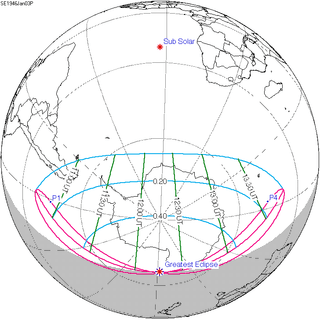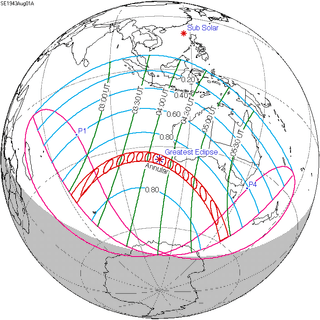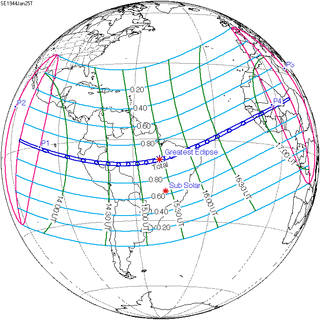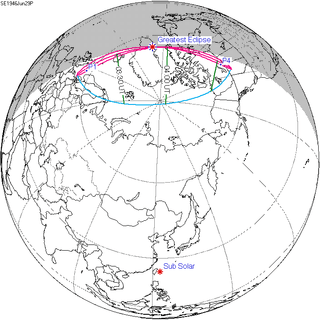Solar eclipse of January 3, 1946
| Solar eclipse of January 3, 1946 | |
|---|---|
 Map | |
| Type of eclipse | |
| Nature | Partial |
| Gamma | -1.2392 |
| Magnitude | 0.5529 |
| Maximum eclipse | |
| Coordinates | 67°06′S 177°36′E / 67.1°S 177.6°E |
| Times (UTC) | |
| Greatest eclipse | 12:16:11 |
| References | |
| Saros | 150 (13 of 71) |
| Catalog # (SE5000) | 9388 |
A partial solar eclipse occurred on January 3, 1946. A solar eclipse occurs when the Moon passes between Earth and the Sun, thereby totally or partly obscuring the image of the Sun for a viewer on Earth. A partial solar eclipse occurs in the polar regions of the Earth when the center of the Moon's shadow misses the Earth.
Related eclipses
Solar eclipses 1942-1946
Each member in a semester series of solar eclipses repeats approximately every 177 days and 4 hours (a semester) at alternating nodes of the Moon's orbit.
| Ascending node | Descending node | |||
|---|---|---|---|---|
| 115 | August 12, 1942 Partial |
120 | February 4, 1943 Total | |
| 125 | August 1, 1943 Annular |
130 | January 25, 1944 Total | |
| 135 | July 20, 1944 Annular |
140 | January 14, 1945 Annular | |
| 145 | July 9, 1945 Total |
150 | January 3, 1946 Partial | |
| 155 | June 29, 1946 Partial | |||
References
External links
- Earth visibility chart and eclipse statistics Eclipse Predictions by Fred Espenak, NASA/GSFC
| Wikimedia Commons has media related to Solar eclipse of 1946 January 3. |

